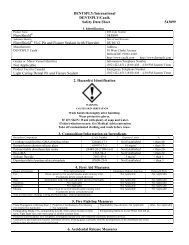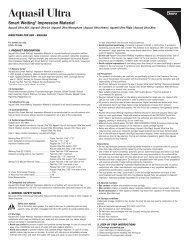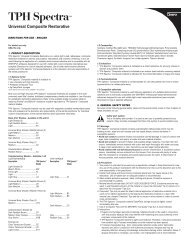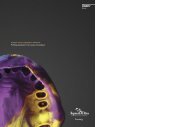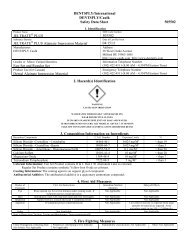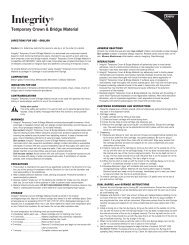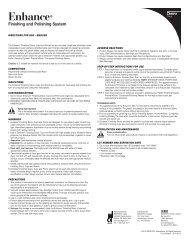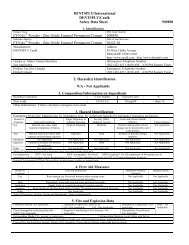SDS - Caulk
SDS - Caulk
SDS - Caulk
You also want an ePaper? Increase the reach of your titles
YUMPU automatically turns print PDFs into web optimized ePapers that Google loves.
DENTSPLY/International<br />
DENTSPLY/<strong>Caulk</strong><br />
Safety Data Sheet<br />
51D898<br />
Product Name<br />
iNterra <br />
Substance Identity<br />
iNterra INoffice Nightguard<br />
Manufacturer:<br />
DENTSPLY <strong>Caulk</strong><br />
Grades or Minor Variant Identities<br />
Not Applicable<br />
Product Use (for Canada)<br />
Not Applicable<br />
1. Identification<br />
<strong>SDS</strong> Code Number<br />
51D898<br />
Date of Last Revision<br />
05/16/13<br />
Address<br />
38 West Clarke Avenue<br />
Milford DE 19963-1805<br />
http://www.caulk.com http://www.dentsply.com<br />
Information Telephone Number<br />
(302) 422-4511 (8:00 AM – 4:30 PM Eastern Time)<br />
Emergency Telephone Number<br />
(302) 422-4511 (8:00 AM – 4:30 PM Eastern Time)<br />
2. Hazard(s) Identification<br />
WARNING<br />
CAUSES SKIN IRRITATION<br />
Wash hands thoroughly after handling.<br />
Wear protective gloves.<br />
IF ON SKIN: Wash with plenty of soap and water.<br />
If skin irritation occurs: Get Medical Advice/attention.<br />
Take off contaminated clothing and wash before reuse.<br />
3. Composition/Information on Ingredients<br />
Hazardous Components C.A.S. Number Exposure Limits %<br />
Acrylated Urethane Dimethacrylate Proprietary Not Established 40 – 50<br />
Aliphatic Ester Urethane Dimethacrylate Proprietary Not Established 10 – 20<br />
Urethane Methacrylate Proprietary Not Established 10 – 15<br />
Methacrylate Ester Proprietary Not Established 3 – 5<br />
Acrylate Ester Proprietary Not Established 1 – 5<br />
Acrylate polymer Proprietary Not Established 10 – 15<br />
4. First Aid Measures<br />
Routes of<br />
First Aid Instructions<br />
Immediate Medical Delayed Effects<br />
Exposure<br />
Attention<br />
Eye Immediately flush victim’s eyes with large quantities of water, holding the eyelids Not Applicable Not Applicable<br />
apart. Get medical attention if irritation persists.<br />
Skin<br />
Remove contaminated clothing. Wash skin thoroughly with soap and water. Get Not Applicable Not Applicable<br />
medical attention if irritation develops. Launder contaminated clothing before re-use.<br />
Inhalation Remove victim to fresh air. Get medical attention if irritation develops. Not Applicable Not Applicable<br />
Ingestion If small quantities are swallowed, rinse out mouth with water. Do not induce Not Applicable Not Applicable<br />
vomiting. Never give anything by mouth to an unconscious or drowsy person. If<br />
irritation or discomfort occurs, get immediate medical attention.<br />
Mucosa Immediately flush victim’s eyes with large quantities of water, holding the eyelids Not Applicable Not Applicable<br />
apart. Get medical attention if irritation persists.<br />
Note to Physicians (Treating, Testing and Monitoring): Treat symptomatically.<br />
Flashpoint: >356F (180C)<br />
Flame Propagation or Burning Rate<br />
(for Solids): Not Applicable<br />
5. Fire Fighting Measures<br />
Flammable (Explosive) Limits in Air<br />
LEL: Not Applicable UEL: Not Applicable<br />
Properties Contributing to Fire Intensity:<br />
Not Applicable<br />
Autoignition Temperature: Not Established<br />
Flammability Classification: Not Applicable<br />
Other: Not Applicable
Extinguishing Media: CO 2, foam or dry chemical.<br />
Extinguishing Media to Avoid: Water with full jet.<br />
Protection and Procedures for Firefighters: Firefighters should wear full emergency equipment and NIOSH approved positive pressure self-contained breathing<br />
apparatus. Cool exposed containers with water spray.<br />
Unusual Fire and Explosion Hazards: High temperatures and sunlight may cause a polymerizing reaction to occur. Decomposition may release acrid smoke or<br />
fumes.<br />
6. Accidental Release Measures<br />
Containment Techniques: Material is a paste and as such will not flow.<br />
Spill/Leak Clean-up Procedures and Equipment: Avoid gross skin contact to minimize the possibility of contact dermatitis to susceptible persons. Ensure<br />
adequate ventilation. Wear protective clothing. If product is uncured, expose to sunlight or artificial light to cause the resin to polymerize. Pick up cured material<br />
and place into a container for disposal.<br />
Evacuation Procedures: Not Applicable Special Instructions: Not Applicable Reporting Requirements: Not Applicable<br />
7. Handling and Storage<br />
Handling Practices and Warnings: Avoid contact with the eyes, skin and clothing. Wear protective clothing and equipment as described in section 8. Wash<br />
thoroughly with soap and water after handling. Keep container closed when not in use. Avoid breathing dust of cured material. Use with adequate ventilation.<br />
Product is intended for dental use only. Handling of this product should be by trained dental healthcare professionals only. Observe normal care for working with<br />
chemicals. Empty containers retain product residues can be hazardous. Follow all M<strong>SDS</strong> precautions when handling empty containers.<br />
Storage Practices and Warnings: Store in a tightly closed container in a cool, well-ventilated area. Material is light sensitive. Light will cause product to<br />
polymerize. Do not store in direct sunlight or near excessive heat. Protect from physical damage. Keep away from oxidizers and other incompatible materials.<br />
8. Exposure Control / Personal Protection<br />
Ventilation: None required during normal intended use of this product.<br />
Engineering Controls: None normally needed. When grinding or polishing, use local exhaust ventilation to minimize dust exposure levels.<br />
Personal Protective Equipment for Normal Use<br />
Individual<br />
Protection<br />
Measures<br />
Personal Protective<br />
Equipment for<br />
Emergencies<br />
Eye/Face None needed under normal use conditions. Wear safety glasses when grinding or<br />
Not Applicable<br />
polishing<br />
Skin<br />
The glove material has to be impermeable and resistant to the product.<br />
Not Applicable<br />
Wear latex, PVC or other impervious gloves to minimize skin contact.<br />
Inhalation Not Required in normal use. When grinding, polishing or where exposure levels are<br />
Not Applicable<br />
excessive, an approved respirator with dust/mist cartridges or supplied air respirator<br />
appropriate for the form and concentration of the contaminants should be used.<br />
Selection and use of respiratory equipment must be in accordance with appropriate<br />
regulations and good hygiene practice.<br />
Body Protection Impervious clothing as needed to prevent contact. An eyewash should be available in Not Applicable<br />
the immediate work area.<br />
General Hygiene Considerations and Work Practices: Keep away from foodstuffs, beverages and feed. Immediately remove all soiled and contaminated clothing.<br />
Wash hands before breaks and at end of work. Avoid contact with the eyes and skin.<br />
Protective Measures During Repair and Maintenance of Contaminated Equipment: Not Applicable<br />
Other Protective Measures and Equipment: Not Applicable<br />
9. Physical and Chemical Characteristics<br />
Appearance: Clear semi solid.<br />
Odor: Characteristic acrylate odor.<br />
Normal Physical State: Very High Viscosity Liquid (Paste)<br />
Melting Point:
Eyes: Direct contact may cause irritation with redness, burning and tearing. Dust from grinding or polishing may cause mechanical irritation.<br />
Skin: Uncured product may cause mild irritation or cause contact dermatitis on prolonged contact. Not irritating in primary skin irritation studies. The cured and<br />
uncured product tested negative in a Kligman Maximization Test with guinea pigs. Repeated or prolonged contact with the unpolymerized material may cause<br />
sensitization for persons allergic to acrylates and methacrylates used in dental materials.<br />
Inhalation: Dust from grinding or polishing may cause sneezing, coughing and other signs of mechanical irritation.<br />
Ingestion: No adverse effects are expected from swallowing small amount. This product was found to be non-toxic in tests with laboratory animals.<br />
Chronic Health Effects: Prolonged or repeated skin contact with uncured material may cause skin irritation or sensitization in some individuals.<br />
Carcinogenicity: None of the components are listed as carcinogens by OSHA, IARC, or NTP.<br />
Mutagenicity: The cured product tested negative in the Ames Mutagenicity Test.<br />
Medical Conditions Aggravated by Exposure: Individuals with pre-existing respiratory disorders may be at increased risk from exposure.<br />
Acute Toxicity Data: Tests were conducted on cured and uncured extracts in water and sesame oil in mice. A single dose of 40 ml/kg was gavaged and the animals<br />
were observed for 14 days for any signs of toxicity. Under the conditions of the study, the extracts were not considered toxic.<br />
Emergency Overview Material is irritating to eyes, respiratory system and skin.<br />
Routes of<br />
Single, Repeated, or Severity (Mild, Acute and Chronic Health Effect(s) Target Organ(s)<br />
Exposure Signs and Symptoms Lifetime Exposure Moderate, Severe)<br />
Eye<br />
Material can cause<br />
Single Moderate Irritation and possible corneal damage Not Applicable<br />
Skin<br />
irritation.<br />
Material may be an<br />
irritant<br />
Single & Repeated Moderate Irritation or possible allergic response.<br />
Severe allergic response may result in<br />
breathing difficulties.<br />
Not Applicable<br />
Inhalation Not Applicable Not Applicable Not Applicable Not Applicable Not Applicable<br />
Ingestion Material is not harmful if<br />
swallowed using clinically<br />
relevant quantities<br />
Not Applicable Mild Not Applicable Not Applicable<br />
Mucosa<br />
Material can cause<br />
Single Mild Inflammation of the mucosa Not Applicable<br />
irritation.<br />
Medical Conditions Aggravated by Exposure Open sores and wounds of the skin. Individuals with known sensitivity to methacrylates, acrylates, or urethane<br />
dimethacrylate resin used in Dental restorative products.<br />
Carcinogenicity NTP?: Not listed IARC monographs?: Not listed OSHA regulated?: No All components of this product are in<br />
compliance with the inventory listing Requirements of the U. S. Toxic Substances Control Act (TSCA) Chemical Substance Inventory.<br />
Potential Environmental Effects Do not allow to enter sewers/ surface or ground water.<br />
NFPA Hazard Classification Ratings (Scale 0-4), Health = 1, Fire = 1, Reactivity = 0<br />
12.Ecological Information<br />
Toxicity Data, Environmental Fate, Physical/Chemical Data, or other Data Supporting Environmental Hazard Statements: Water<br />
Hazard class1 (Self-assessment): slightly hazardous for water. Do not allow undiluted product or large quantities of it to reach<br />
ground water, water streams or sewage system.<br />
13.Disposal Considerations<br />
Regulations: Must not be disposed of together with household garbage. Do not allow product to reach sewage system.<br />
Larger quantities should be disposed of in accordance with Federal, State and Local regulations. This product will polymerize<br />
when exposed to sunlight. Small gram amounts can be allowed to polymerize to a hard solid and then disposed of normally.<br />
Properties (Physical/Chemical) Affecting Disposal: Dispose of material as solid waste in a closed container.<br />
14.Transport Information<br />
Regulated for Shipping: No. Not Regulated DOT Shipping Name: Not Regulated Packing Group: Not Applicable<br />
Do Changes in Quantities, packaging, or shipment DOT Hazard Class: Not Applicable UN Number: Not Applicable<br />
method change product classification? No<br />
15.Regulatory Information<br />
This product has been classified in accordance with the hazard criteria of the Globally Harmonized System of Classification and Labeling of<br />
Chemicals and the <strong>SDS</strong> contains all of the information required by the Canadian Controlled Products Regulations.<br />
U.S. Federal Regulations: CERCLA 103 Reportable Quantity: This product is not subject to CERCLA reporting requirements. Many states have<br />
more stringent release reporting requirements. Report spills required under federal, state and local regulations<br />
Section 313 Toxic Chemicals: This product contains the following chemicals subject to Annual Release Reporting Requirements Under SARA<br />
Title III, Section 313 (40 CFR 372): None<br />
SARA TITLE III: Hazard Category for Section 311/312: Acute Health.<br />
Section 302 Extremely Hazardous Substances (TPQ): None<br />
EPA Toxic Substances Control Act (TSCA) Status: This product is a medical device and is not subject to chemical notification requirements. All<br />
of the components of this product are listed on the TSCA inventory.<br />
U.S. State Regulations California Proposition 65: This product contains the following substance known to the state of California to cause<br />
reproductive toxicity (birth defects) Toluene
European Inventory of New and Existing Chemicals Substances (EINECS):<br />
This product is a medical device and not subject to chemical notification requirements.<br />
Other: Not Applicable<br />
16.Other Information<br />
To the best of our knowledge this product does not contain gluten, wheat grains, flaxseed, natural rubber, or natural latex.<br />
All components are synthetically produced; none are derived from animal products.<br />
This information is based on our present knowledge. However, this shall not constitute a guarantee for any specific products features and shall not establish a<br />
legally valid contractual relationship.<br />
The attached safety data sheet covers the dangers and measures to be taken when large quantities of material are released, for example due to accidents during<br />
transport or storage by the dealer. For quantities of material typically used in clinical practice, information necessary for safe use and storage of the product is given<br />
in the DFU.



